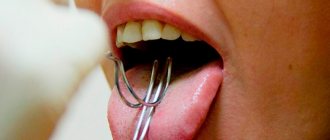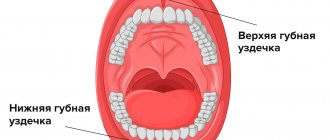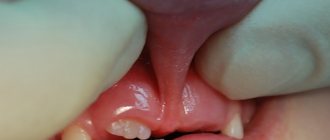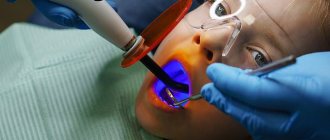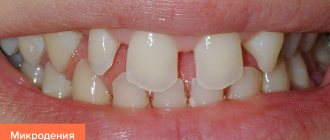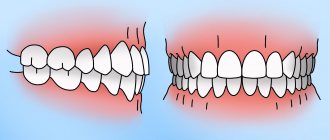If your child speaks poorly or you notice obvious signs of malocclusion in your baby, you should go for a consultation with a pediatric dentist. You can get rid of these and other problems with a simple procedure - you need to correct a short frenulum of the tongue in a child.
The frenulum of the tongue is a bridge that connects the tongue and the lower palate. It is responsible for how the tongue functions, affects speech, the ability to drink and eat, and swallow. The condition of the frenulum even affects the breathing process!
Here there is the possibility of pathology consisting in insufficient length, which leads to the recommendation to trim the frenulum of the child’s tongue. Why is it needed?
Let's consider the reasons for the need for this operation for children from a very early age. For newborn babies, sucking is a vital function. It is she who suffers in case of frenulum pathology. If it is not trimmed, the baby will not be able to drink mother's milk, including from a bottle with a nipple. It must be said that surgery in early childhood is easier to tolerate than in adulthood, so parents should not worry about the baby’s well-being.
Further, if a short frenulum of the tongue is detected at an older age, doctors advise surgery to prevent the defect from affecting the formation of the bite, and to avoid speech problems and disturbances in the process of eating.
Short frenulum of the tongue - what is it?
But let's look at the problem in more detail. So, short frenulum of the tongue - what is it? The bridge connecting the tongue to the palate, or simply a special ligament if not long enough, significantly reduces the mobility of the tongue. It would seem that this is a trifle. However, children with this problem very clearly suffer from inconvenience. Moreover, it gets worse with age. When baby teeth are replaced by permanent ones, a short frenulum will not allow the dentition to form correctly, which almost always carries a high risk of caries, gum disease and other unpleasant problems.
There are 5 different types of pathology, each of which brings specific discomfort to the child’s life:
- thin and transparent - limits the mobility of the tongue;
- thin and translucent - causes a semblance of bifurcation of the tip of the tongue when directed upward;
- thick - limits the mobility of the tongue;
- dense and very short, combined with the muscles of the tongue - along with cleft lips and palate;
- dense and very short, combined with the muscles of the tongue, severely limits the mobility of the tongue.
The next question naturally arises: who to turn to? If the baby is unable to stick out his tongue or reach his upper teeth, we can conclude that there is a possibility of pathology. However, the final verdict must be made by a professional. The specialist who will make the appropriate diagnosis must conduct an examination of the oral cavity. Most often this is a dentist, but doctors of other specializations can also evaluate the elasticity and length of the frenulum, the normal value of which is 8 mm for 5 years of age.
Most often, a short frenulum is a congenital pathology, including hereditary. The cause of the defect in the child can be viral diseases, stress, toxicosis or other factors during the mother’s pregnancy. It is important to understand that even in the absence of obvious discomfort, trimming is necessary to eliminate the risk of problems in the future.
How to fix the problem and who to contact? The decision on the length of the tongue frenulum is made by parents during a consultation with a dentist. The defect can be eliminated surgically or with the help of special gymnastic exercises for articulation.
The method of eliminating the defect is selected by the dentist individually depending on parameters such as the degree of shortening, the presence of consequences, localization, and the age of the child.
Which method is suitable in your case depends on the surrounding circumstances. So, if a short frenulum is discovered in the first days of a child’s life and directly affects his nutrition, surgery on the frenulum of the tongue is necessary, which is often performed right in the maternity hospital. Please note that for newborns the process will be completely painless! It is also worth operating if an incorrect bite is formed or has formed. After frenuloplasty, the child will experience some discomfort associated with a change in diction. This is a temporary phenomenon that can be easily eliminated by classes with a speech therapist and special gymnastics for the tongue.
If a child has a burr, speech therapy disorders associated with pronunciation and speech can be corrected by performing a set of exercises to develop and stretch the frenulum.
Features of the anatomical structure of the foreskin
The foreskin is represented by folds of skin, which are one of the elements of the protective cover covering the male penis.
One of the folds is located along the body of the latter and connects the foreskin and the head of the penis to each other. It's called a bridle. The features of this anatomical formation are such that it can stretch when the flesh moves, or during sexual intercourse, when friction is performed. In the latter case, if the frenulum is of sufficient length, the head receives additional stimulation due to slight bending. If it is too short or the skin folds do not have the desired elasticity, complete exposure of the head of the penis during erection becomes impossible, so this defect can only be identified during the boy’s puberty. Treatment of a short frenulum of the foreskin is simply necessary, since this defect is characterized by a number of extremely unpleasant manifestations for any man. The penis becomes cosmetically defective, appearing curved during erection. During sexual intercourse, a man feels pain, and the frenulum, due to excessive tension, can tear and even rupture. Due to scarring of wounds, the defect intensifies, causing disruption of erectile function, emotional distress, and even fear of sexual relations.
At what age should this be done?
If we talk about a non-surgical method for stretching the hyoid ligament, it is effective up to the age of 5 years with constant and regular training.
The operation as a whole has no restrictions and no special recommendations about at what age it should be done. Each stage of development of a child’s body requires one of several ways to correct this ligament. Thus, newborns undergo a dissection of the frenulum, and already at the age of 2–3 years, when the tissue of the ligament becomes denser, the need for sutures arises. Sometimes it may be necessary to remove some of the ligament tissue. Laser surgery has no age restrictions.
To avoid the formation of malocclusion and displacement of the dentition, it is advisable to correct the frenulum before the molars appear.
Why does a short frenulum of the foreskin develop?
In the vast majority of cases, this defect is congenital, often combined with a pathological condition such as phimosis. The latter is characterized by the narrowness of the foreskin, which does not allow the head of the penis to be exposed.
It is found in 96% of newborn boys, but as their body develops, the foreskin gains the necessary mobility, and the problem goes away on its own. At the age of three, it is found in only 10% of young patients.
The causes of a short frenulum are as follows:
- different rates of development of skin structures and cavernous bodies of the penis;
- inflammatory processes of the structures of the penis, occurring in a chronic form;
- constant injury to the foreskin when playing sports, wearing incorrectly selected underwear and too tight trousers;
- diabetes mellitus, which provokes failures in tissue regeneration.
How to correct a short frenulum of the tongue?
Let's consider a surgical method to solve the problem. How to correct a short frenulum of the tongue? There is a scalpel method and laser surgery. The first involves mechanical incision (in one of several options) and suturing of the ligament if necessary. All this takes place under local anesthesia. The operation takes on average 30 minutes.
Frenumplasty can be performed in different ways. It is possible to make incisions to the ligament followed by sutures in the lower and upper parts, incisions on the sides, as well as moving the attachment site of the ligament.
The recovery period lasts about a week. At this time, swelling and slight pain may occur. After 10 days, the stitches will begin to dissolve. During recovery, care must be taken when eating, and the baby's parents should monitor this. In addition, the dentist may recommend rinsing the mouth with a special solution or using healing medications.
Care and prevention
After cutting the bridle in Perovo, it is recommended to adhere to the established rules, namely:
- the doctor may prescribe a course of antibiotics;
- until the wound heals completely (4-7 days), exclude sour, spicy and salty dishes, as well as solid and hot foods from the menu;
- hygienic measures are carried out according to the instructions of the treating dentist;
- avoid chemical and mechanical irritants; brush your teeth only with soft-bristled brushes;
Children easily tolerate bridle cutting in Perovo. Infants are allowed to feed immediately, but older children must refrain from eating for the first 2 hours after surgery. The dentist will prescribe antiseptic rinses and healing preparations to lubricate the wound. Complete rehabilitation will take no more than 3-5 days.
Frenum trimming in Perovo is carried out by qualified and experienced dentists. They perform corrections of any level of complexity. All procedures are carried out effectively and painlessly by specialists.
Frenum trimming with laser
Laser frenulum trimming is a simpler, faster procedure that does not cause bleeding. Laser procedures are distinguished by their antibacterial effect, comfortable perception of the procedure by the patient, and the absence of a long recovery period. The laser beam instantly seals the vessels of the frenulum of the tongue, which does not require sutures. Pain relief is usually done using a gel or spray.
Don't be afraid to sign your child up for surgery. By solving the problem with the length of the frenulum, you will give your baby freedom of diction and free him from the feeling of constraint. Make an appointment at the Mira clinic for a consultation by phone.
Frenum of the lower lip
Dentists say that not all babies have a frenulum on the lower lip; it may be completely absent or forked. To study the length of the frenulum, the same technique is used as for studying the frenulum of the upper lip. Normally, the frenulum should be thin and attached in the middle of the body of the jaw. An important condition is that the frenulum of the lower lip must coincide with the center line between the incisors. If these conditions are not met, the bridle is short.
A short oral frenulum interferes with breastfeeding, as the baby cannot properly latch onto the mother's nipple. Fortunately, this situation is quite rare; the most typical manifestation of a short frenulum in the oral cavity is the presence of inflammatory gum diseases in the area of the lower incisors and malocclusion according to the same principle as in the upper jaw.
There are no age restrictions when excision of the mandibular frenulum; usually the mandibular frenulum is diagnosed and corrected at approximately the same time. The principle of the operation is similar to correction on the upper jaw.
Methods of treating RDD at 4 years of age
Correction of delayed speech development in children 4 years old takes place with the participation of a speech therapist, neurologist, psychologist, and ENT doctor. First, a diagnosis is carried out, during which specialists identify the cause of the defect, find out the features of the course of the antenatal, intranatal (childbirth period) and postpartum period. They study the outpatient card, previous diseases, the nature of physical and neuropsychic development up to one year and at an older age.
This is followed by the stage of hardware examination methods to clarify the diagnosis and exclude organic pathology of the ear, brain, and articulation organs. Electroencephalography, X-ray, MRI or CT scan of the brain, and audiometry are performed. After an accurate diagnosis has been made, treatment for mental retardation begins at 4 years of age: it should be comprehensive, using various methods.
Held:
- Drug treatment - nootropics, sedatives, vitamins, as well as herbal medicines;
- Speech therapy correction - speech therapy massage of the tongue, lips, facial muscles, articulation gymnastics, breathing exercises;
- Physiotherapeutic procedures, including magnetic therapy, acupuncture;
- General massage;
- Physiotherapy.
All treatment procedures are prescribed by a specialist. He knows the characteristics of your child’s 4-year-old RRD, the cause, and based on this he selects an individual treatment regimen. It is unacceptable to independently prescribe a drug, even if it is herbal, to change the dose of a medicine prescribed by a doctor or to cancel it.
An important component of successful treatment is eliminating the cause of the defect. Conflicts, quarrels, mental and physical stress should be avoided.
With the timely start of the correctional program, the absence of severe neurological and mental pathology, and the active participation of the child and parents in the treatment process, the prognosis is favorable. Children's pathological pronunciation of sounds disappears, they begin to speak correctly, clearly and expressively. They ask and answer questions competently. The vocabulary is gradually expanding.
A 4-year-old child diagnosed with RRD is being registered at a dispensary. Specialists monitor him and monitor his further development of speech skills. This is necessary to prevent relapse of the disease. If this happens, it is important to start therapy on time.
Causes of delayed speech development in children 4 years old
Various reasons lead to 4-year-old developmental disorder. Some of them affect the fetus in the womb, some - during childbirth and after birth.
Antenatal reasons:
- complications of pregnancy, threat of miscarriage, toxicosis, gestosis;
- illnesses of the expectant mother - exacerbation of chronic diseases, infectious and inflammatory, injuries, intoxication, bad habits;
- conditions that led to fetal hypoxia - placental pathology (anomalies, abruption), umbilical cord entanglement.
During childbirth:
- premature birth;
- rapid labor;
- injuries during childbirth;
- inadequate management of labor, use of obstetric forceps.
After childbirth, delayed speech development in children 4 years of age can result from:
- injuries, especially traumatic brain injuries, are dangerous for speech development;
- diseases - neurological, for example, cerebral palsy, encephalopathy;
- unfavorable family situation - conflicts, parents do not care for the child;
- the opposite situation is overprotection, excessive pressure and demanding parents;
- excessive stress - physical (sports), mental (overload with activities).
Predisposing factors are a hereditary predisposition to RRD at 4 years of age. These may be genetic disorders, congenital abnormalities of the nervous system,
When to see a doctor
By the age of 4, children know up to 2000 words, speak clearly, pronouncing words clearly. In speech they use extended phrases of several words. They know how to inflect words and use them correctly in a sentence. They show interest in new words and understand the plot of a fairy tale or short story. Difficulties can be caused by complex words, hissing and sonorant sounds. But these are physiological norms that do not require specialist intervention.
Delayed speech development in children 4 years old can be suspected when they have deviations: in the rate of speech, pronunciation of sounds. Because of problems, the baby prefers to remain silent or speaks fragmentarily.
IRR at 4 years of age increases the likelihood of neurological and even mental abnormalities. An inferiority complex gradually develops, the baby is embarrassed or afraid to communicate with peers, and behaves separately. In the future, this will affect the learning process, academic performance and mastery of the school curriculum. Children whose parents ignore the child’s problem and do not engage in his development are especially in a difficult situation.
Therefore, at the first signs of a speech disorder, you should consult a doctor and begin treatment.
Peculiarities of manifestation of delayed speech development in children 4 years old
Features of delayed speech development in children 4 years old are slow or fast speech, blurred sounds, omissions of letters or syllables. Some children do not pronounce words at all or abbreviate them, replacing words with syllables, gestures, and facial expressions.
Characteristic symptoms:
- difficulties in formulating the question and in answering the question addressed to him; the answers are usually monosyllabic (“yes”, “no”, “there”, “here”);
- poor vocabulary - usually uses only those words that are used in everyday life;
- incorrect pronunciation of complex words;
- skipping syllables and sounds;
- lack of skills in composing a simple story or sentence based on a picture;
- replacing words that sound similar;
- There are no hissing or whistling sounds in the articulation, or the patient pronounces them incorrectly;
- replacing sounds with easier ones to pronounce;
- lack of criticism of speech errors in oneself and other people.
Consultation with an anesthesiologist
Before the operation, a consultation with an anesthesiologist is required, where the doctor examines the test results and explains how anesthesia will be administered. For children's anesthesia, the safest modern drug, Sevoran, is used, which will be administered through a mask. The anesthesiologist and anesthesiological nurse monitor the condition of the little patient throughout the entire operation, monitoring all vital signs using equipment. The clinic has a postoperative ward, where the child rests for some time after the operation under anesthesia. After being examined by an anesthesiologist, you can go home.
According to the tests, there were no contraindications for treating the child under anesthesia, so the date for the operation was set.



